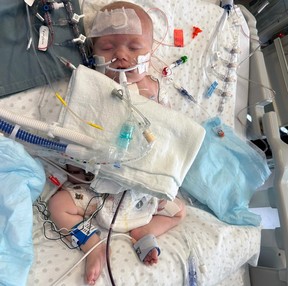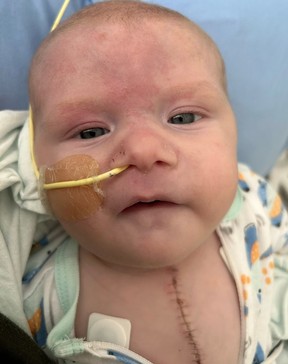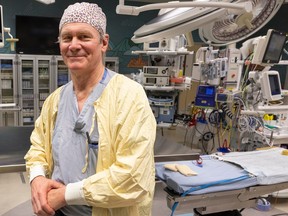Baby Arlo at B.C. Children’s Hospital, after a historic surgery in fall 2023 by Dr. Mohammed Al Aklabi that saved the newborn’s life. sun
Baby Arlo is alive today because of medical advances applied by B.C. Children’s Hospital cardiac surgeon Mohammed Al Aklabi
Baby Arlo’s uphill battle for survival began in the early months of his mother’s pregnancy, when an ultrasound revealed the tiny fetus had a potentially fatal heart defect.
“The picture that was painted for us when Arlo was still inside was very bleak,” said his mother, Leanne Epp.
“It wasn’t looking good for him. It’s bad when they’re suggesting abortion or termination because they don’t think that it will go well.”
In the end, though, everything did go relatively well, after groundbreaking work by the cardiac team at B.C. Children’s Hospital. Today, Arlo is an energetic, inquisitive, six-month-old, a long scar on his chest the only visible sign of the complicated open-heart surgery that saved his life.
Arlo’s condition at birth was “very complex” and there was talk, at first, that little could be done to help him, said Dr. Mohammed Al Aklabi, the hospital’s head of cardiac surgery.
“But I think we pushed the limits. We gave him a chance,” said Al Aklabi, who performed Arlo’s open-heart surgery. “And his heart is almost like normal now.”

The hiring of Al Aklabi is one of several changes at both B.C. Children’s and B.C. Women’s to improve outcomes for newborns with very sick hearts. The others include being the first Canadian hospital to insert a tiny pacemaker into an infant, which Postmedia reported on Saturday.
During a recent interview, a bouncy baby Arlo squeezed Al Aklabi’s finger. That, the surgeon said, is the “big reward” for the work he does.

Getting to this point, though, was a hellish journey for Arlo’s parents.
Epp, who lives in Agassiz with her husband and two sons, stayed at Ronald McDonald House to be close to the hospital for the last two months of her pregnancy. Arlo was born in April with pulmonary atresia with ventricular septal defect, which means the valve that allows blood to flow from the heart to the lungs was not fully developed, and there was a major hole in the heart.
Arlo’s case was also complicated by major aortopulmonary collateral arteries, little interlopers that grow on the main aorta to try to make up for missing blood vessels to the lungs.
Epp knew her baby would need open-heart surgery, but the hope was to let him grow for six months to improve his odds of survival. The surgery was done on July 19, when he was just three months old, after he could no longer breath on his own and started to go into heart failure.
“It was devastating. One of the worst feelings is coming into the hospital with your sick baby, not knowing if you’ll be able to come out,” she recalled.

The team made a new artery for Arlo’s lungs, gave him a new valve for his heart, and closed the hole in his heart, Al Aklabi said.
“This child was actually not meant to survive the surgery, or anything, but this is one example of a success story,” added Al Aklabi, who works as a pediatric cardiac surgeon in both Vancouver and Edmonton.
He estimated B.C. Children’s cardiac surgeons operated on 500 children over the last two years, and 40 of those were extremely complex cases. Previously, he said, those 40 children would have had low chances of survival, or would have lived with significant challenges.
Part of the reason for his department’s success, he said, is collaboration with experts in other children’s hospitals, such as in Edmonton, and technological advancements, like the use of 3D ultrasound images to better diagnose defects.

B.C. Children’s has not been immune to the challenges facing hospitals across Canada. It still has lengthy waiting lists for surgeries, a result of many procedures being cancelled during the pandemic, said Skarsgard.
Staffing in the medical system has also been a struggle, and the hospital still has unfilled nursing positions it is “working desperately hard to fill.” It has hired a third cardiac surgeon and is being “creative about scheduling” to maximize access to specialists, such as anesthesiologists, he added.





